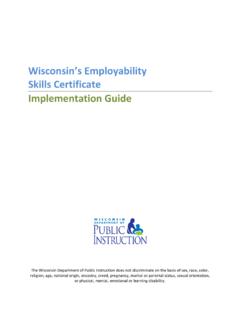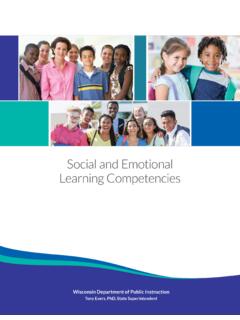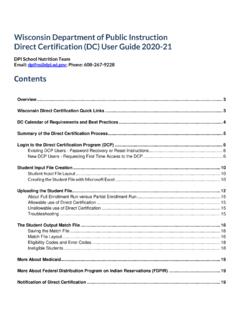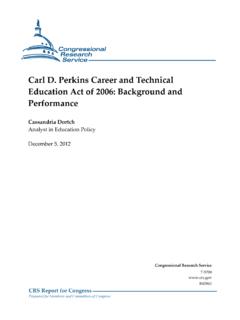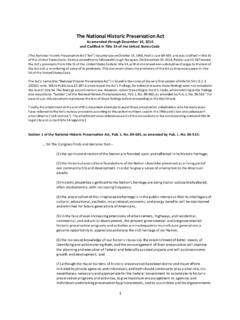Transcription of Carl D. Perkins Career and Technical Education Act of 2006 ...
1 CRS Report for CongressPrepared for Members and Committees of Congress Carl D. Perkins Career and Technical Education Act of 2006 : implementation Issues Cassandria Dortch Analyst in Education Policy December 14, 2012 Congressional Research Service 7-5700 R42858 Carl D. Perkins Career and Technical Education Act of 2006 : implementation Issues Congressional Research Service Summary The Carl D. Perkins Career and Technical Education Improvement Act of 2006 ( Perkins IV; 109-270) supports the development of academic and Career and Technical skills among secondary Education students and postsecondary Education students who elect to enroll in Career and Technical Education (CTE) programs, sometimes referred to as vocational Education programs.
2 Perkins IV was authorized through FY2012, which ended on September 30, 2012. The authorization is extended through FY2013 under the General Education Provisions Act. This report provides a summary of potential reauthorization issues that Congress may consider in the 113th Congress. Potential reauthorization issues and recommendations have been put forward by the Department of Education , the Obama Administration s blueprint for reauthorization of Perkins IV, stakeholder and advocacy groups, and program evaluations. If Congress considers reauthorization of the Perkins act, key issues may include the following: To what extent should the federal government support CTE and in what ways, given competing priorities and an environment of fiscal constraint?
3 How can the validity, reliability, and consistency of Perkins IV performance measures be improved to better assess program effectiveness while still allowing states flexibility to structure their CTE programs to meet state/local needs? How can the Technical skills, academic/disciplinary proficiency, pedagogical, and classroom management capabilities of pre-service and in-service CTE teachers be maximized to ensure CTE students are academically and technically proficient? How can the secondary to postsecondary transitions and postsecondary completions of CTE students be facilitated and increased?
4 What kinds of relationships should be fostered between the Perkins act, the Workforce Investment Act of 1998 (WIA; 105-220), and business and industry to strengthen the nation s workforce development system? What is the optimal involvement of local business and industry representatives in the development and maintenance of CTE programs to ensure the CTE programs provide relevant curriculum and Technical skills that respond to regional or national labor markets and that maximize the students post- Education opportunities? How should Perkins IV funds be allocated to the states in the event of a potential decrease in funding levels?
5 Should the Perkins IV funding mechanism be modified to balance the continuation of CTE programs with increased innovation in the development and delivery of CTE programs? Carl D. Perkins Career and Technical Education Act of 2006 : implementation Issues Congressional Research Service Contents Introduction and Program Background .. 1 Potential Reauthorization Issues .. 3 Level of Federal Support for CTE .. 4 Lack of Reliable and Comparable Outcome Data .. 4 Program Evaluation .. 6 Adequacy of Secondary Teacher Qualifications and Professional Development .. 7 Improving Secondary to Postsecondary 8 Tech Prep.
6 8 Programs of Study (POS) .. 9 Relationship with the Workforce Investment Act .. 10 Sustainable and Relevant Business Involvement .. 11 Alternative Funding Mechanisms .. 12 State Formula Allocations .. 12 Within State Competitive Versus Formula Funding .. 13 Contacts Author Contact 13 Carl D. Perkins Career and Technical Education Act of 2006 : implementation Issues Congressional Research Service 1 Introduction and Program Background The Carl D. Perkins Career and Technical Education Improvement Act of 2006 ( Perkins IV; 109-270) is intended to develop the academic and Career and Technical skills of secondary and postsecondary Education students who elect to enroll in Career and Technical Education (CTE) programs, particularly programs that prepare students for high-skill, high-wage, or high-demand occupations in current or emerging professions.
7 CTE, sometimes referred to as vocational Education , provides occupational and non-occupational preparation at the secondary, postsecondary, and adult Education As defined in a publication by the Department of Education s (ED s) National Center for Education Statistics (NCES), collectively, CTE prepares students for roles outside the paid labor market, teaches general employment skills, and teaches skills required in specific occupations or For example, CTE provides preparation in homemaking and a variety of occupations, such as nursing, business administration, culinary arts, automotive maintenance, software programming, engineering technology, and cosmetology.
8 Perkins IV authorizes five main programs: the Basic State Grants program, the Tech Prep grant program, the Tribally Controlled Postsecondary Career and Technical Institutions grant program (TCPCTIP), National Programs, and Occupational and Employment Information. Over 90% of the funds appropriated under Perkins IV are used to provide Basic State Grants. These formula grants are awarded to the 50 states, the District of Columbia, the Commonwealth of Puerto Rico, and each outlying area. States subsequently make grants to support CTE activities at the secondary and postsecondary levels primarily in local educational agencies (LEAs), area CTE schools, and community colleges.
9 Grant recipients are expected to develop rigorous and challenging academic and Technical standards and assist students in meeting such The standards must incorporate linkages between secondary and postsecondary Education . Grantees must also implement one program of study (see box below); provide professional development that improves the quality of CTE instruction and counseling; and support partnerships among educational institutions, local workforce investment boards, and business and industry. 1 CTE is also referred to as Career Education , Technical and vocational Education (TVET), and Technical Education .
10 For more information on CTE, see CRS Report R42748, Career and Technical Education (CTE): A Primer, by Cassandria Dortch. 2 K. Levesque, J. Laird, E. Hensley, Choy, Cataldi, and L. Hudson, Career and Technical Education in the United States: 1990 to 2005 (NCES 2008-035), National Center for Education Statistics, Institute of Education Sciences, Department of Education . Washington, DC, 2008, p. B-2. 3 The academic curriculum and standards must be aligned with the Elementary and Secondary Education Act, as amended by the No Child Left Behind Act of 2001 (NCLB). Carl D. Perkins Career and Technical Education Act of 2006 : implementation Issues Congressional Research Service 2 Programs of StudyPrograms of study (POS) were intended as a major innovation and improvement to Perkins IV in comparison to the Perkins act as previously authorized, the Carl D.





